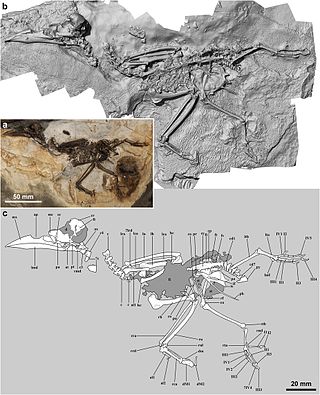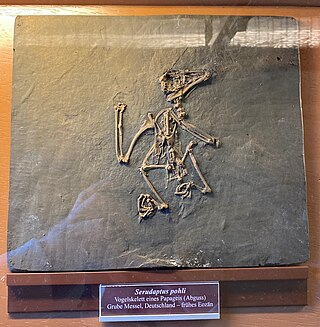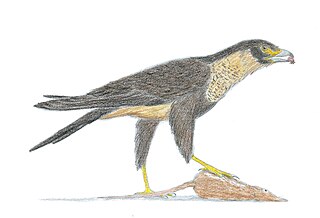
The Coraciiformes are a group of usually colourful birds including the kingfishers, the bee-eaters, the rollers, the motmots, and the todies. They generally have syndactyly, with three forward-pointing toes, though in many kingfishers one of these is missing. The members of this order are linked by their “slamming” behaviour, thrashing their prey onto surfaces to disarm or incapacitate them.

Coraciidae is a family of Old World birds, which are known as rollers because of the aerial acrobatics some of these birds perform during courtship or territorial flights. The family contains 13 species and is divided into two genera. Rollers resemble crows in size and build, and share the colourful appearance of kingfishers and bee-eaters, blues and pinkish or cinnamon browns predominating. The two inner front toes are connected, but not the outer one.

The mousebirds are birds in the order Coliiformes. They are the sister group to the clade Cavitaves, which includes the Leptosomiformes, Trogoniformes (trogons), Bucerotiformes, Piciformes and Coraciformes. This group is now confined to sub-Saharan Africa, and it is the only bird order confined entirely to that continent, with the possible exception of turacos which are considered by some as the distinct order Musophagiformes, and the cuckoo roller, which is the only member of the order Leptosomiformes, and which is found in Madagascar but not mainland Africa. Mousebirds had a wider range in the Paleogene, with a widespread distribution in Europe and North America during the Paleocene.

The ground rollers, Brachypteraciidae, are a small family of non-migratory birds restricted to Madagascar. They are members of the order Coraciiformes and are most closely related to the rollers in the family Coraciidae.

Strigogyps is an extinct genus of prehistoric bird from the Middle Eocene to Early Oligocene of France and Germany. It was probably around the size of a large chicken or a guan, weighing not quite 1 kilogram (2.2 lb). Apparently, as indicated by the ratio of lengths of wing to leg bones, S. sapea was flightless. Its legs were not adapted to running, so it seems to have had a walking lifestyle similar to trumpeters. Unlike other Cariamiformes which appear to have been mostly carnivorous, the specimens of one species, Strigogyps sapea, suggest a facultatively herbivorous or omnivorous diet.
Paleontology or palaeontology is the study of prehistoric life forms on Earth through the examination of plant and animal fossils. This includes the study of body fossils, tracks (ichnites), burrows, cast-off parts, fossilised feces (coprolites), palynomorphs and chemical residues. Because humans have encountered fossils for millennia, paleontology has a long history both before and after becoming formalized as a science. This article records significant discoveries and events related to paleontology that occurred or were published in the year 1998.
Paleontology or palaeontology is the study of prehistoric life forms on Earth through the examination of plant and animal fossils. This includes the study of body fossils, tracks (ichnites), burrows, cast-off parts, fossilised feces (coprolites), palynomorphs and chemical residues. Because humans have encountered fossils for millennia, paleontology has a long history both before and after becoming formalized as a science. This article records significant discoveries and events related to paleontology that occurred or were published in the year 2000.

Masillaraptor is an extinct genus of masillaraptorid, a group of primitive falconiforms, from the Middle Eocene Messel Pit, Germany. It is a long-legged relative of the living falcons.

Lithornithidae is an extinct, possibly paraphyletic group of early paleognath birds. They are known from fossils dating to the Upper Paleocene through the Middle Eocene of North America and Europe, with possible Late Cretaceous representatives. All are extinct today; the youngest specimen is the currently unnamed SGPIMH MEV1 specimen from the mid-Eocene Messel Pit site.
Eurofluvioviridavis is a genus of extinct birds from the Middle Eocene Messel Pit, Germany. It contains a single species, Eurofluvioviridavis robustipes. It is related to Avolatavis and Vastanavis, other members of the family Vastanavidae.

Messelornis, also known as the Messel rail, is an extinct genus of gruiform bird, closely related to modern rails. It is the most abundant bird from the Messel Lagerstätte, representing roughly half of all Messel bird fossils with more than 500 specimens known. The fossil record are from the Paleocene to the early Eocene.

Dinosaur coloration is generally one of the unknowns in the field of paleontology, as skin pigmentation is nearly always lost during the fossilization process. However, recent studies of feathered dinosaurs and skin impressions have shown the colour of some species can be inferred through the use of melanosomes, the colour-determining pigments within the feathers.
Pumiliornis tessellatus is an ancient bird from the Middle Eocene of Messel, Hesse, Germany. It is described as a wren-sized anisodactyl bird with a long, slender bill and strong hallux. Its species name tessellatus, meaning "mosaic" in Latin, is a reference to its unusual distribution of characters and uncertain phylogenetic placement. It has some anatomical affinities with Cuculiformes, but similar fossils that might be related to this taxon do not.

The Messel Formation is a geologic formation in Hesse, central Germany, dating back to the Eocene epoch. Its geographic range is restricted to the Messel pit. There it unconformably overlies crystalline Variscan basement and its Permian cover (Rotliegend) as well as Eocene volcanic breccias derived from the basement rocks. The formation mainly comprises lacustrine laminated bituminous shale renowned for its content of fossils in exceptional preservation, particularly plants, arthropods and vertebrates.

Septencoracias is an extinct genus of bird related to modern rollers and other Coraciiformes such as kingfishers, bee-eaters, motmots, and todies. It contains two species, Septencoracias morsensis described in 2016, and S. simillimus, which was named in 2024. It was found in the Fur Formation of Denmark, dating back to the Ypresian of the Lower Eocene Epoch, about 54 million years ago. Septencoracias is one of the earliest known members of Coraciiformes, lending insight into the earliest radiation of this group.

Messelasturidae is an extinct family of birds known from the Eocene of North America and Europe. Their morphology is a mosaic that in some aspects are very similar to modern hawks and falcons, but in others are more similar to parrots. Initially interpreted as stem-owls, more recent studies have suggested a closer relationship to parrots and passerines. Their ecology is enigmatic.

Halcyornithidae is an extinct family of telluravian birds thought to be related to the Psittaciformes (parrots), Passeriformes (songbirds), and to the extinct Messelasturidae. Halcyornithids have been found in various Eocene formations in Europe and North America. Widespread and diverse in the Early Eocene of North America and Europe, halcyornithids are not found in locales later than the Middle Eocene. Halcyornithids were small, arboreal birds with zygodactyl feet, with two toes facing forwards and two facing back, a trait shared with other tree-dwelling families of Eocene birds like the Zygodactylidae and the messelasturids. The skull of halcyornithids features a ridge of bone above the eye called the supraorbital process, similar to birds of prey. The relationships of the halcyornithids to other birds remain uncertain. Halcyornithids have been proposed as relatives to owls and as a lineage closer to parrots than to songbirds. Most recently, halcyornithids have been identified as the sister group of the clade including parrots and songbirds. It is also possible that Halcyornithidae is paraphyletic with respect to the Messelasturidae.
This is an overview of the paleofauna of the Eocene Messel Formation as explored by the Messel Pit excavations in Germany. A former quarry and now UNESCO World Heritage Site, the Messel Formation preserves what once were a series of anoxic lakes surrounded by a sub-tropical rainforest during the Middle Eocene, approximately 47 Ma.

Masillaraptoridae is an extinct family of stem-group falconiform birds from the Eocene of Europe. They are noted for their relatively long legs. Two genera have been named: Danielsraptor, from the London Clay of England, and Masillaraptor, from Messel Pit in Germany.

Serudaptus is an extinct genus of halcyornithid bird from the Middle Eocene Messel pit in Hesse, Germany. The genus contains one species, Serudaptus pohli, and is known for long, raptorial claws on its zygodactyl feet.























